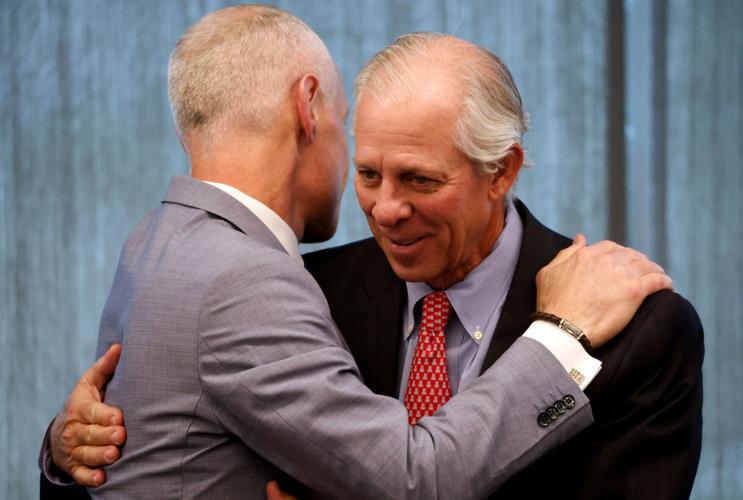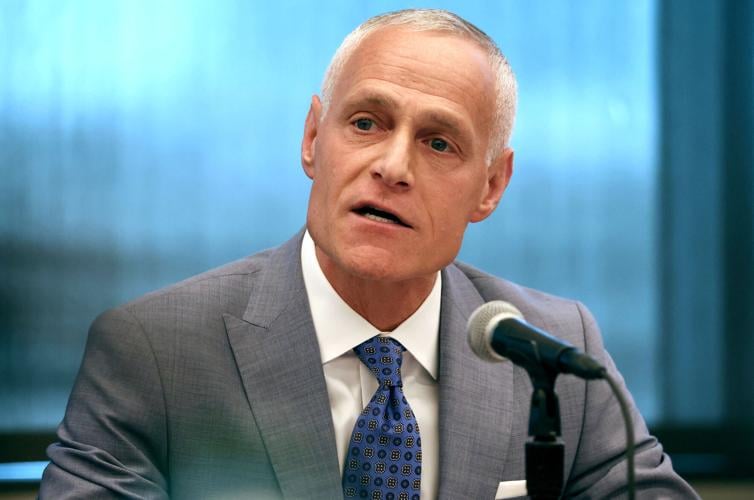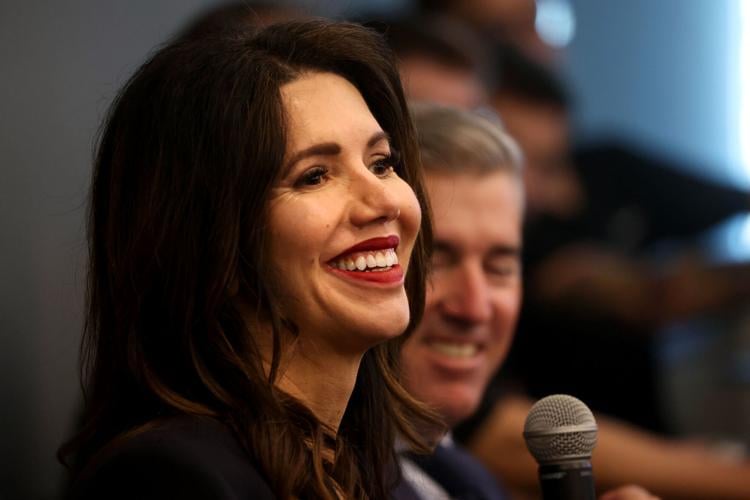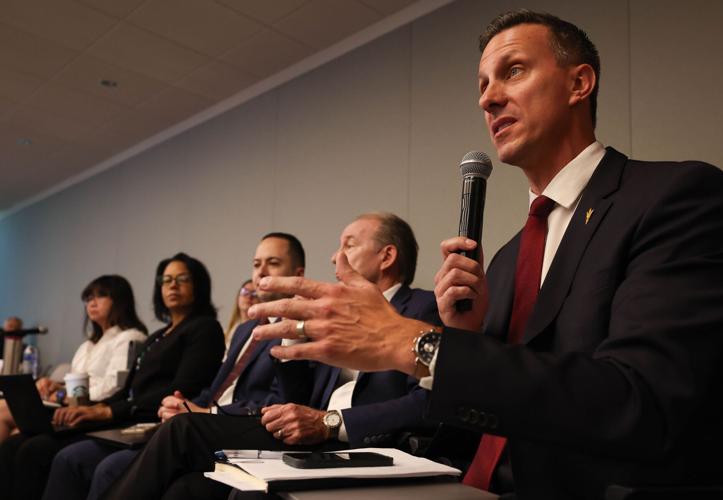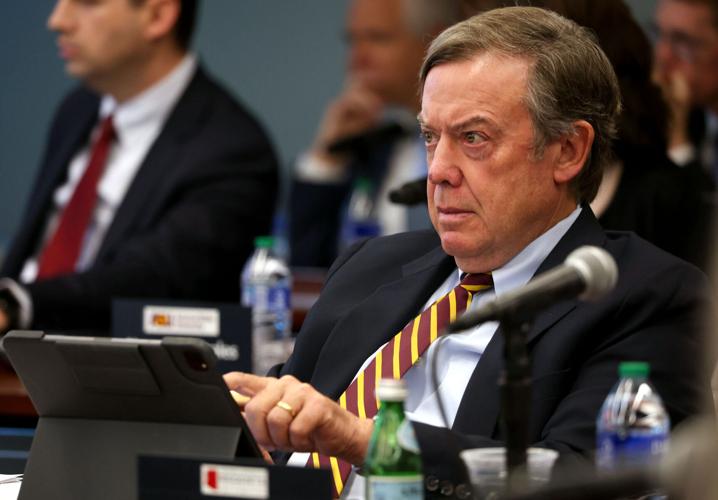After a sharp 30-minute presentation Thursday on the Big 12’s strategy and priorities, commissioner Brett Yormark opened the floor to questions from the board — the Arizona Board of Regents.
Those questions covered a range of topics, from content strategy to the transfer portal and NIL (name, image and likeness) to the future of college sports.
Yormark spoke of the need for innovation and bold decisions but was understandably short on specifics at the Fulton Center on Arizona State’s Tempe campus. Because of ongoing court cases, nobody knows exactly what form college athletics will take in the second half of the decade and beyond.
But this much was clear: Every path to success will require a significant financial commitment by Arizona and ASU by their athletic directors, their presidents, their donors and their governing board.

Big 12 commissioner Brett Yormark speaks to the Arizona Board of Regents Thursday in Tempe, detailing the conference’s objectives and how it fits into the rapidly evolving world of college athletics.
Which is why the last sentence of the final slide in Yormark’s presentation resonated loudly: We must continue to invest in college athletics.
Athletics “drives enrollment, it drives philanthropy,” Yormark told the board. “I would impress upon you to lean in, to be a resource in every way possible.”
Leaning in became both more important and more challenging last month, when the Power Five conferences agreed to settle a multi-billion-dollar antitrust lawsuit brought against the NCAA by former ASU swimmer Grant House.
If approved by Judge Claudia Wilken of the Northern District of California, the House v. NCAA settlement will carry a price tag of approximately $30 million annually for the Wildcats and Sun Devils and their colleagues in the power conferences:
Roughly $20 million for a revenue-sharing agreement with the athletes. (The specifics of how that revenue will be shared across sports, and within teams, have not been determined.)
Approximately $10 million to increase the number of scholarships for multiple sports.
The revenue-sharing amount likely will increase over time because it’s hooked to the total revenue generated by athletic departments. And those revenues will rise thanks to escalator clauses in TV deals and the expanded College Football Playoff.

Arizona State University President Michael Crow listens to Big 12 Commissioner Brett Yormark’s in-person remarks to the Arizona Board of Regents Thursday in Tempe.
This comes as Arizona and ASU navigate massive budget deficits.
The Wildcats reported a slight operating surplus in the 2023 fiscal year but needed $44 million in university support to make the math work. The Sun Devils weren’t any better off, with a $27 million deficit despite $16.6 million in campus support.
Notably, the regents didn’t push back on Yormark’s call for investment.
In fact, Lyndel Manson, who chaired the committee responsible for Yormark’s presentation (Strategic Initiatives and Planning), showed a firm grasp of the issues and echoed a concern on many campuses: That sharing revenue with the athletes and paying for their scholarships could be considered “double-dipping.”
“A lot of people feel that way,” Yormark responded.
Whether the legal system agrees is another matter, for the NCAA’s abysmal record in court is one reason Yormark was short on specifics.
If Wilken approves the House settlement, implementation in the fall of 2025 will undoubtedly spark another round of legal challenges, many of them likely focused on Title IX, the 1972 federal law that guarantees equal opportunity for female athletes.

University of Arizona President Robert Robbins listens during a meeting Thursday of the Arizona Board of Regents.
Will the courts force schools to divide the revenue-sharing amount ($20 million) equally between male and female athletes? How much can go to football and men’s basketball players? Will schools have to eliminate sports to offset the increased expenses?
Also unknown: How House will impact NIL collectives, and whether it will end the barrage of antitrust lawsuits against the NCAA.
After all, the groundbreaking settlement was not collectively bargained by a labor union because college athletes don’t have a labor union. Nor do they need one.
Why form a union when you can transfer whenever you want and play immediately?
Why form a union when you can share revenue and have scholarships paid for and receive NIL compensation?
“There’s never been a better time than right now to be a student-athlete,” Yormark told the regents. “They are being treated like employees but not classified as employees.”
And therein lies the crux of the NCAA’s predicament:

Arizona State University athletic director Graham Rossini speaks during an Arizona Board of Regents meeting Thursday in Tempe.
Decades of missteps sparked the legal challenges that toppled the system and created the current anarchy — the very same anarchy that benefits the athletes so thoroughly that they have no motivation to form the unions that would lead to collective bargaining and the implementation of guardrails.
Which means more upheaval is guaranteed, and the likelihood of cost containment is less than zero.
As a result, the pressure will mount on the Arizona Board of Regents and similar oversight entities across the country — to approve investment in college athletics.

University of Arizona athletic director Desireé Reed-Francois speaks during an Arizona Board of Regents meeting Thursday in Tempe.
“We have a responsibility to compete at the highest level,” Arizona athletic director Desireé Reed-Francois told the regents.
“Revenue sharing is part (of that). We’re going to participate, but there are a lot of details we’re working through.”
One detail requires no vetting in Tucson or Tempe, in Eugene or Austin or Ann Arbor: Until the NCAA bargains collectively with a players union, cost control in college athletics is merely a dream.
Big 12 commissioner Brett Yormark, UA athletic director Desireé Reed-Francois and ASU AD Graham Rossini discuss the seismic changes coming to college sports in a meeting with the Arizona Board of Regents.


